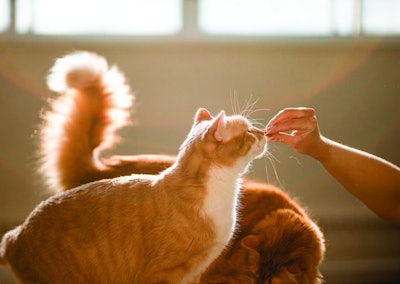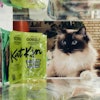
During the pandemic, as pet owners (existing and new) locked down with their furry family members, they rewarded the comfort and companionship with plenty of pet treats—to the tune of nearly US$10 billion in 2021 in the U.S. alone, according to Packaged Facts.
Yet treats have represented a growth story since before the pandemic, helping drive an increase in the overall pet food market for several years. This is especially true with cat treats, which have outpaced dog treats in sales every year since 2016, wrote David Sprinkle, research director and publisher with Packaged Facts, in Pets International magazine.
Lucky pets getting a lot of treats
On top of the years-long growth history, the pandemic accelerated U.S. pet treat sales to double-digit increases for two years in a row: an astounding 20% in 2020 and another 15% in 2021. While that level of growth is likely not sustainable, Packaged Facts is still projecting a compound annual growth rate of 12% through 2025, reaching estimated sales of US$15 billion that year.
To dive into the continually rising sales, consider that in 2019, average treat sales per U.S. dog were US$68; that increased to US$82 in 2020 and US$95 in 2021. For cat treats, the amounts were US$23, US$30 and US$35 per cat, respectively, per Packaged Facts data.
That means a lot of pets getting a lot of treats during the pandemic. Accordingly, indulgent treats had the largest market share, at 36%, followed by rawhides and long-lasting chews for dogs at 32% (possibly to keep them occupied while their owners were doing Zoom meetings and/or helping their kids with online schooling?).
Yet the ongoing focus on pet health and wellness, which also accelerated during the pandemic, has translated to functional treats capturing a 17% market share, with dental treats close behind at 15%, according to Packaged Facts.
Cat treat usage on the rise everywhere
While dog treats still account for 80% of the U.S. pet treat market, as noted before, cat treats have been gaining share for several years. In fact, since Packaged Facts began tracking usage of treats and other types of pet food in 2006, the U.S. usage rate of cat treats has risen from 39% then to 60.4% in 2020-21. This contrasts with dog treats and biscuits, which started out much higher (a 75.5% usage rate in 2006-07) but have remained relatively flat (77% usage in 2020-21).
And it’s not just cats in the U.S. that are increasingly enjoying treats. A survey of 1,776 cat owners in Canada, France and the U.K., in addition to the U.S., conducted in 2022 by Pets International and online pet community Yummypets, showed that only 17% never give treats to their cats. Conversely, 36% treat their cats once a day, and 16%, multiple times a day. Other frequencies covered in the survey included once a week (22%) and once a month (9%).
French cat owners are most likely to never give treats (while they tend to free-feed cat food), as are “elderly owners,” according to Pets International. (A personal aside: This U.S. cat owner never gives treats, but that’s because my picky cat—well, aren’t they all?—won’t eat them.)
Among the cat owners in this survey, the most popular type of cat treats are crunchy ones, given by 53%, which may align at least partially with the indulgent treat category cited in Packaged Facts data. Dental treats also show up here, given by 22% of owners, followed by catnip or cat grass at 21%.
All these data help support that cat treats will continue to be a growth category, as dog treats likely will continue to contribute significant sales, too.


















